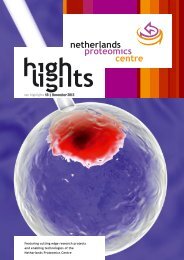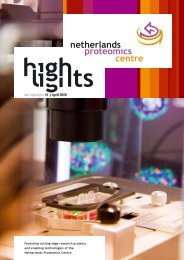NPC Progress Meeting 2012 - Netherlands Proteomics Centre
NPC Progress Meeting 2012 - Netherlands Proteomics Centre
NPC Progress Meeting 2012 - Netherlands Proteomics Centre
- No tags were found...
You also want an ePaper? Increase the reach of your titles
YUMPU automatically turns print PDFs into web optimized ePapers that Google loves.
proteins involved, we have to chop these complex compoundsinto pieces. The fractions obtained are called peptides; theseare simpler and easier to investigate. Nowadays, mass spectrometryis the tool used most often for protein and peptideanalysis, but it is not possible to analyse real samples consistingof complex mixtures directly. A previous separation step isnecessary and that is where my research begins.The heart of the techniqueThe technique used for separating the peptides is liquid chromatography(LC). The most important part of this instrumentis the column, which is also called ‘the heart of the technique’.You could ask, what is this column? How does it separatethe peptides? The column is a very narrow tube filled withreally small particles. The peptides go through the columnmoved by a liquid stream and interact with these particles.Some peptides are attracted by the column particles morestrongly than others resulting in slower transport. Seperationof the peptides has been based on these different speeds.The column particles involved are extremely small spheres.To give you an idea: a grain of salt used in the kitchen has adiameter of 1mm. The particles inside the column are approximately300 times smaller with a diameter of 3.0 µm!High pressureOf what importance is my research if everything to this pointis known? The idea is that by using smaller particles, forexample 1.8 µm instead of 3.0 µm, the final separation will beimproved. The development of a new LC system applying suchsmaller particles is what we target. But how much differencecould there be between 3.0 µm and 1.8 µm? What would constitutesomething new? To answer these questions you need toknow that the column diameter measures 50 µm, comparableto the thickness of a hair. The problem with these small sizesis that enormous pressure is necessaryto transport the peptidesthrough the column. If with the3.0 µm particles the pressuremeasures about 300 bar, withthe 1.8 µm particles a pressureof approximately 1000 bar isnecessary. Keep in mind that thepressure on the wheels of a carFigure 2 | Pressure of a wheel is about 2 bar;is only 2 bar! (see Figure 2)pressure that the UHPLC can handle amountsA pressure of 1000 bar is really1200 bar.high; developing an instrumentthat can handle such pressureis not easy. A few researchers have tried to modify existinginstruments to withstand extremely high pressures. However,we opted to launch a new instrument, called UHPLC (Ultra-HighPressure Liquid Chromatography). Apart from handling higherpressure (up to 1200 bar), UHPLC is not very different fromusual HPLC (High Pressure Liquid Chromatography), which canreach maximum 400 bar.The real workNow that we know what we want to do, let´s get down towork. The first thing we need to do is prepare a column.Several companies sell them, but they are quite expensive.Luckily in our group there is a person highly experienced inthis task, so we decideto make the columnsourselves. Filling a reallynarrow column with suchsmall particles is not easy(see Figure 3): a greatdeal of experience, technique(to make the particlesgo inside the column)and time are required.Imagine looking through amicroscope at how a tube,as narrow as a hair, isfilled with particles 1000times smaller than a grain Figure 3 | Zoom in on the particlesof salt! These particles inside the column (left). Keep in mindthat the diameter of the column isstop, get blocked, then bysimilar to the thickness of a hair.utilising some tricks, weget them to move again.In fact, a whole day is needed to pack a column of 40 cm inlength with 1.8 µm particles. Using 3.0 µm particles it is mucheasier: we can make up to four of those per day. To quote aSpanish proverb: ‘Patience is the mother of science.’ You canimagine out how much patience is needed.As working with the small 1.8 µm particles is new, we need tostudy many parameters to get the best results. The speed ofthe liquid that transports the peptides through the column isone such parameter. When we use the 3.0 µm particles, speedmakes a difference. However, in our case using the 1.8 µmparticles, we find that applying different speeds, varying from50 to 200 nL/min, leads to similar results. As you can see, thespeed is quite slow, on the order of nanoliters. To fill a 1.5 lbottle of water at such slow speed we would need more than28 years! Many studies have demonstrated that this low speedis the best one for this type of analysis.The moment of truthAfter studying some more parameters and optimising themethods, the moment of truth has arrived. Do we identifymore peptides and proteins with this new UHPLC system thanwe did before using the HPLC system? Yes, we identify 30%more! So, after quite some time, effort and patience, wefinally get what we wanted. These are the secret ingredientsas indicated by the question in Figure 1. When you buy a newcomputer, it can take a bit of time for you to get used to itand benefit from all the advances. The same is true for proteinanalysis tools. Just by making a bit of effort at the beginning,a higher number of proteins can be identified, thereby speedingup the research.In this essay Alba Cristobal (Spain)describes her project during the Erasmusexchange one year ago. After receiving herChemistry MSc in Spain, she came back andjoined Albert Heck’s Biomolecular MassSpectrometry and <strong>Proteomics</strong> Group (UU)as a PhD student in October 2011. She isnow finishing this small particle project andwill begin new ones on one dimensionalproteomics.| 23






